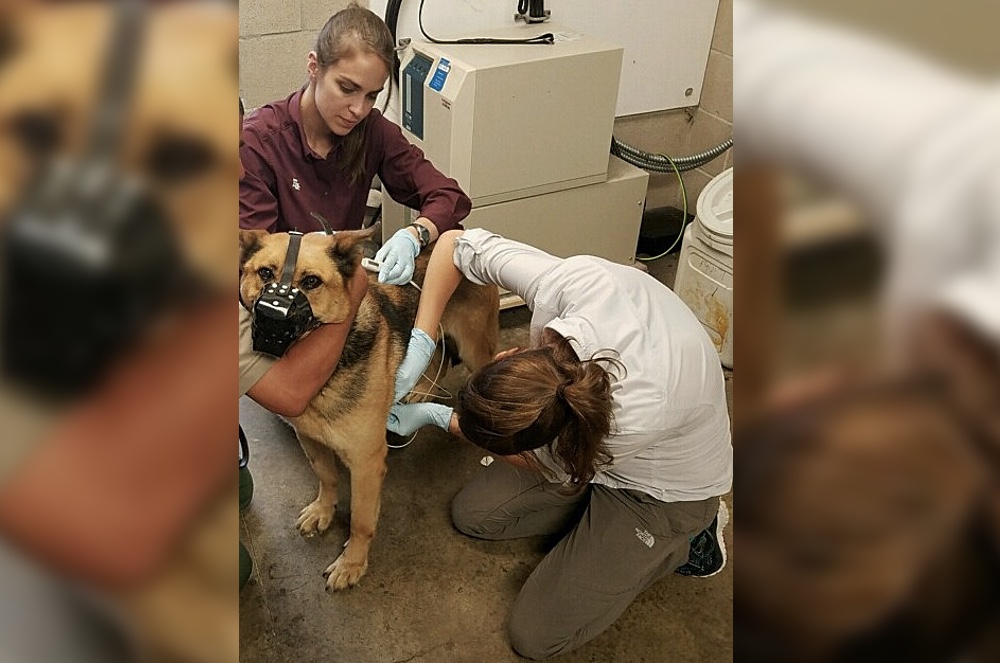US Homeland Security Dogs Face a Growing Occupational Risk: A Nasty Parasite

Humans aren't the only ones who have occupational hazards: Working dogs can face them, too.
Case in point: A new study finds that a surprising number of dogs working for the U.S. Department of Homeland Security are infected with the parasite Trypanosoma cruzi, which causes Chagas disease, an illness that can occur in both humans and dogs.
The study analyzed blood samples from 1,660 federal working dogs that aid in tasks including border patrol, search and rescue, and detecting drugs and explosives, as well as helping guard federal buildings. The researchers found that 121 dogs, or about 7 percent of those tested, had antibodies against T. cruzi, which indicate an ongoing infection. [7 Surprising Health Benefits of Dog Ownership]
Concerningly, many of the infected dogs also showed signs of heart problems — a complication of Chagas disease that can be fatal.
And although the insects that transmit the disease, known as triatomine bugs or kissing bugs, have been found in parts of the United States — particularly the South — some of the infected dogs served in states outside the bugs' known range, including Northern states.
"We were surprised to find that so many dogs, including those working outside of the kissing bug range, had been exposed to the parasite T. cruzi, and were exhibiting heart abnormalities associated with the disease," lead study author Alyssa Meyers, a doctoral candidate at Texas A&M University, said in a statement.
Meyers presented the findings today (Oct. 31) at the American Society for Tropical Medicine and Hygiene annual meeting in New Orleans. The study has not yet been published in a peer-reviewed journal.
Sign up for the Live Science daily newsletter now
Get the world’s most fascinating discoveries delivered straight to your inbox.
Disease moves northward
Historically, Chagas disease was found only in Mexico, Central America and South America. But the disease has been making its way north — although most U.S. cases of Chagas disease are caused by infections acquired in Latin America, a small number of human infections have been acquired in southern and southwestern states as Arizona, Arkansas, Louisiana, Mississippi, Tennessee and Texas. What's more, kissing bugs have been found in 27 states, and a growing number are known to carry the T. cruzi parasite, the researchers said.
In both people and dogs, the infection can initially cause fever and fatigue. But afterward, the parasites may remain "hidden" in the body for years, or even a lifetime, according to the Centers for Disease Control and Prevention. In some cases, this chronic infection can lead to heart problems, including an enlarged heart or abnormal heart rhythms.
Federal working dogs train at facilities in Texas and Virginia, two states where infected kissing bugs are known to be found.
Dogs may be exposed to infected kissing bugs by spending long hours outdoors, particularly at night when the bugs are most active, the researchers said. Dogs may also be exposed in kennels, where the large number of closely housed animals can attract kissing bugs and allow them to thrive.
Previously, researchers had found evidence that dogs working along the U.S. border with Mexico were at risk for infection with T. cruzi. But the new study also found infection in dogs that spend most of their time working along the Canadian border, and in dogs patrolling airports in Nebraska, a finding that was unexpected, Meyers said.
Finding Chagas disease in dogs in a given area may be an early warning sign that the disease may soon appear in people there too. But currently, it's difficult to say what the new findings mean for human risk, in part because the researchers are uncertain about exactly how the dogs picked up the infection.
In addition, dogs may be at higher risk of infection than people, in part because they "have a tendency to eat bugs that could be infected with the parasite, and dogs spend more time outdoors," Meyers said.
Dogs' heart health
The researchers also outfitted some of the dogs with a wearable electrocardiogram, or ECG, that monitored the dogs' hearts. The monitors showed that more than two-thirds of the infected dogs had early signs of heart problems linked to Chagas disease, the researchers said.
However, there are no treatments for Chagas disease specifically for dogs, and even existing treatments for humans may not be effective later during the infection.
Currently, the dogs are being monitored for progression of their heart problems.
The researchers are also planning a study to find ways to reduce federal dogs' exposure to kissing bugs while training or on the job.
Originally published on Live Science.

Rachael is a Live Science contributor, and was a former channel editor and senior writer for Live Science between 2010 and 2022. She has a master's degree in journalism from New York University's Science, Health and Environmental Reporting Program. She also holds a B.S. in molecular biology and an M.S. in biology from the University of California, San Diego. Her work has appeared in Scienceline, The Washington Post and Scientific American.









